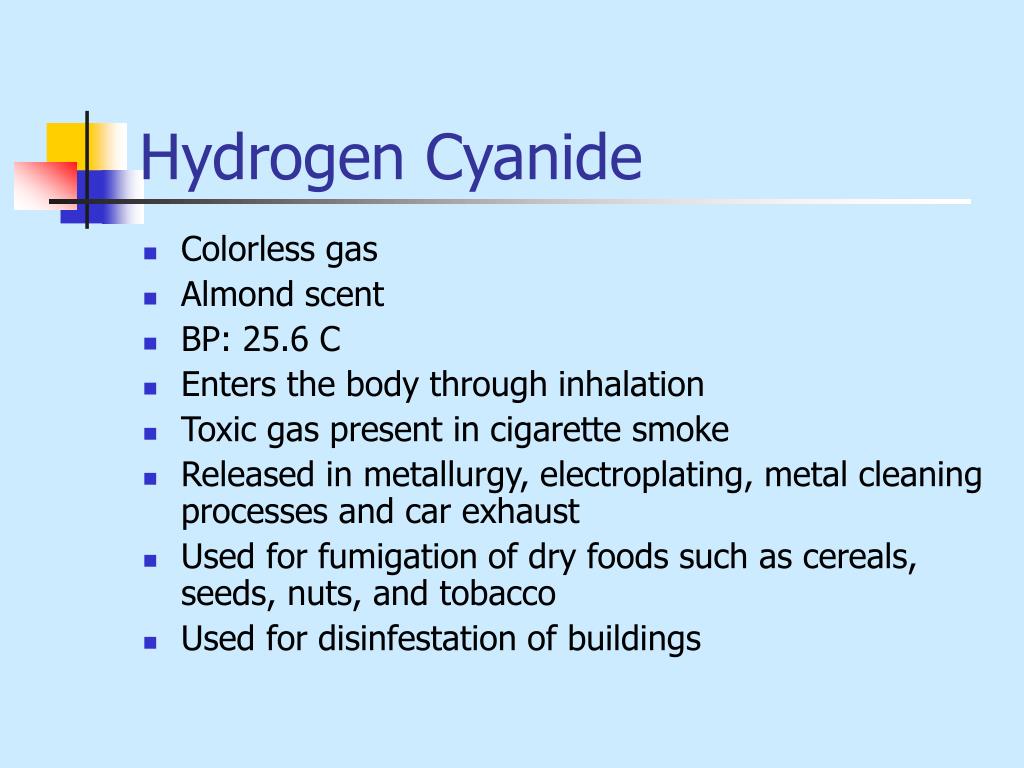

#HYDROGEN CYANIDE PDF#
6017) pdf icon -NMAM sampling and analysis of contaminants in workplace air, and in the blood and urine of workers who are occupationally exposed. 6010) pdf icon -NMAM sampling and analysis of contaminants in workplace air, and in the blood and urine of workers who are occupationally exposed. Immediately Dangerous to Life or Health (IDLH) Value Profile: Hydrogen Cyanide -NIOSH reviews relevant scientific data and researches methods for developing IDLH values.NIOSHTIC-2 search results for hydrogen cyanide-NIOSHTIC-2 is a searchable database of worker safety and health publications, documents, grant reports, and journal articles supported in whole or in part by NIOSH.

Useful search terms for hydrogen cyanide include “formonitrile,” “hydrocyanic acid,” and “prussic acid.” NIOSH Chemical Resources The following resources provide information about occupational exposure to hydrogen cyanide. Visit NIOSH’s page on Managing Chemical Safety in the Workplace to learn more about controlling chemical workplace exposures. NIOSH recommends that employers use the Hierarchy of Controls to prevent injuries. If you work in an industry that uses hydrogen cyanide, please read chemical labels and the accompanying Safety Data Sheets for hazard information. Steel and iron workers who work in plants that harden iron and steel.Factory workers in industries that manufacture acrylic fibers, synthetic rubber, and plastics.Agricultural workers who fumigate outdoor pests in areas such as fruit orchards.Workers who fumigate ships and buildings.Hydrogen cyanide may be used in the workplace for fumigation, electroplating, mining, chemical synthesis, and the production of synthetic fibers, plastics, dyes, and pesticides. Some examples of workers at risk of being exposed to hydrogen cyanide include the following: The level of exposure depends upon the dose, duration, and work being done. Hydrogen cyanide interferes with the body’s use of oxygen and may cause harm to the brain, heart, blood vessels, and lungs. Exposure can be fatal. Workers may be harmed from exposure to hydrogen cyanide. Judging from the relative concentration of each compound in the reaction products, it may be said that 2-methylvinyl, isopropenyl, propyl, allyl, isopropyl, and cyano radicals are the main intermediates in this reaction system.Hydrogen cyanide (HCN) is a colorless or pale-blue liquid or gas with a bitter, almond-like odor. Besides these compounds, the reaction products were confirmed to consist of isopropyl cyanide, acetonitrile, acrylonitrile, 4-methyl-1-pentene, 2,3-dimethylbutane, 1,5-hexadiene, 2-methylpentane, 1-hexene, n-hexane, and gaseous products. When a mixture of propylene and hydrogen cyanide was discharged in an ozonizer in the absence of air, the main liquid products were crotononitrile, methacrylonitrile, and n-propyl cyanide. When the discharge wall of the glass filter was filled with Hg(CN) 2, the yield of acrylonitrile was at its maximum. The yield of acrylonitrile depended upon the packing materials in the glass filter. The present investigation was undertaken to find out whether or not the relative amounts of acrylonitrile obtained by the reaction between ethylene and hydrogen cyanide in a silent discharge are affected by the substances (Hg(CN) 2, Cu, CuCN, Al, Zn and Fe) placed in a glass filter of the special discharge tube, and to examine the possibility of the direct introduction of a cyano radical into propylene by means of the silent discharge.


 0 kommentar(er)
0 kommentar(er)
